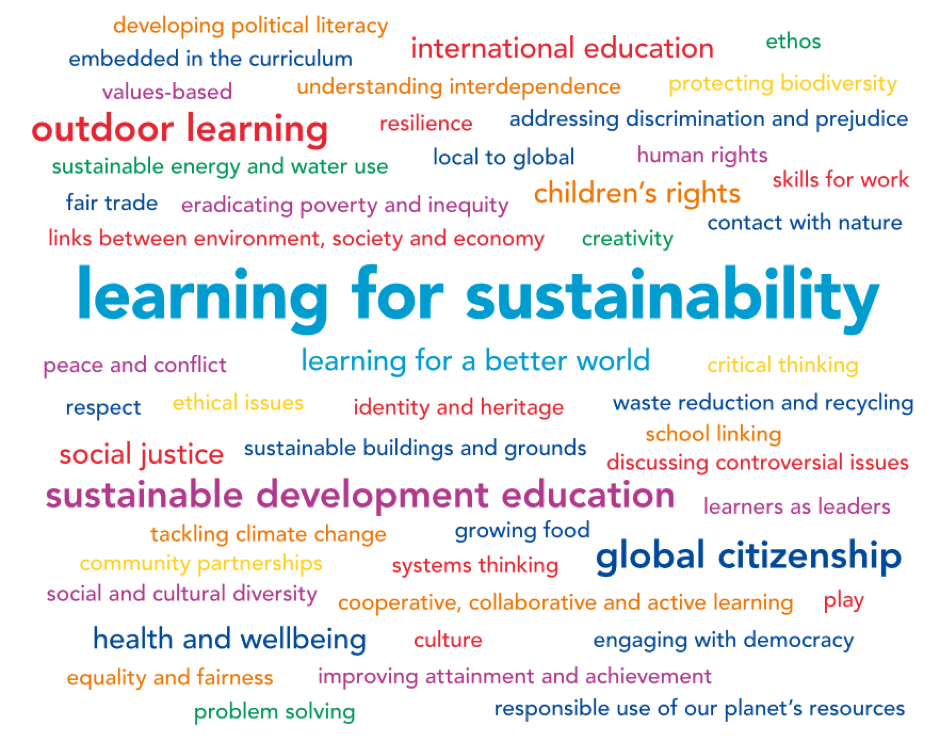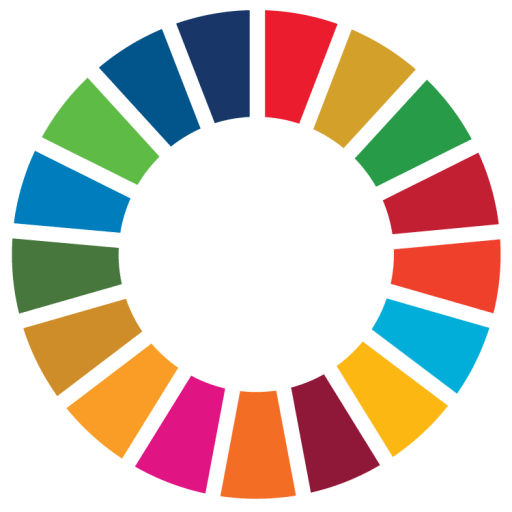Learning for Sustainability – Beyond the Elevator Pitch
‘Learning for Sustainability’ – it’s a broad, embracing term. An umbrella, a basket, a bag of concepts and practices that LfS Scotland member Rob Bushby’s brief elevator pitch tried to capture. As something that all learners in Scotland are entitled to, and with its role as a policy driver in Scottish education re-asserted this summer, Rob considers whether there is a common and consistent understanding in school education of what it is, what it is for, and why it has value for pupils and practitioners.
Origins
Coined in 2012, Learning for Sustainability was first described as “the weaving together of global citizenship, sustainable development education, and outdoor learning”. As its relevance and application were explored, children’s rights and social justice were added to its headline themes, and an abundance of terms added to a word map.

Scottish Government commitments to these were nothing new but hadn’t been captured under one collective banner before. Learning for Sustainability wasn’t set out to be a new and additional ask of teachers. Here’s ‘Building the Curriculum 3’ in 2010:
“children and young people are entitled to experience….a broad general education, including well planned experiences and outcomes across all the curriculum areas. This should include understanding of the world and Scotland’s place in it and understanding of the environment”.
The 2012 report of the One Planet Schools Working Group built upon longstanding contributions of distinguished Scottish thinkers including Sir Patrick Geddes (widely associated with the notion of ‘thinking globally, acting locally’), and conservationists and ecologists such as John Muir and Professor John Smyth. Its authors recognised that “sustainable development education, global citizenship and outdoor learning each makes an essential contribution to building the values, attitudes, knowledge, skills and confidence needed to engage positively with the challenges our society and the world face. These three share much common ground but also have their unique features”.
The Working Group felt that repeated use of the individual terms was cumbersome, and that none encompassed the full breadth of an ambition to “develop practices and take decisions which are compatible with a sustainable and equitable society”. It agreed on the term ‘Learning for Sustainability’ as this related most closely to the Group’s remit.
Practice
Learning for Sustainability is a wide-ranging approach rather than a specific topic. It creates a platform for teachers and educators, whatever their background or specialism, to explore and tackle local and global issues in ways relevant to them. This might be big ticket items such as the global climate emergency or engaging with the UN Sustainable Development Goals, or school-focused responses to nature loss, placemaking, or use of plastics. They can be taught and studied in ways that are meaningful for pupils and contribute to the ‘totality of experience’, including the ethos and life of the school as a community.
Embedded across all curriculum areas, Learning for Sustainability supports the delivery of Curriculum for Excellence and its four capacities, providing a rich context for interdisciplinary learning. It’s being approached through STEM subjects and Citizen Science; it’s providing a context for creating a voice and a narrative through literacy, arts and music, including a RME-based values perspective; it’s integrating learning outside the classroom, embracing nearby nature, including adventure and residential experiences – and multiple combinations of these. Its application impacts on the ethos and life of the school as a community. It is offering opportunities for personal achievement and professional development.
As a broad theme – it’s not a syllabus or set programme – practitioners and pupils engage with Learning for Sustainability in relevant, accessible and inclusive ways and settings, from urban to rural, local to global, focused interrogation to broad overviews…
Policy Driver, Action Plan
Sustainability, the environment and global issues could be education ‘bolt-ons’, considered in isolation. Learning for Sustainability is a policy driver for creating a coherent whole school approach that encompasses curriculum, campus and culture, as well as the wider community in which the school sits. Many are already successfully integrating sustainable development learning and global citizenship, using outdoor learning approaches and collaborating with third sector organisations. The impetus now is for every school in Scotland to ensure that a Learning for Sustainability entitlement is available for all.
Policy is where power lies. It can be both carrot and stick, attracting resource and giving clear direction. It joins things up. It can also be toothless, lie gathering dust, or have layers of bureaucratic permafrost freezing out grassroots delivery.
Now, corralled by Scottish Government and Education Scotland, a raft of key agencies, NGOs and cross-sector partners has committed to a Learning for Sustainability Action Plan giving detailed interpretation to broad recommendations that have been in place since 2016. From Local Authorities (CoSLA) and Scottish Qualifications Authority to the Care Inspectorate and Teacher Professional Associations, there are commitments to raise awareness, share practice, and give Learning for Sustainability prominence in their own strategies and standards.
Deputy First Minister and Cabinet Secretary for Education and Skills John Swinney outlined the Scottish Government ambition in launching the new Action Plan as, “bringing the concept of Learning for Sustainability to life at the heart of the curriculum. ..To make a much broader breakthrough in terms of practice and approach, culture and behaviour across the [education] system as a whole…To produce a learning experience relevant to young people, giving due and proper account of society”.
It aims to effectively respond to the growing interests, passions and concerns articulated by young people about their place in society and on the planet. John Swinney again: “We see with the climate emergency the changing dynamics of the debate and response needed; the world is changing at an ever-increasing pace. We have a curricular approach that can adapt to these needs and can keep pace with the aspirations, frustrations and impatience of young people”.
The potential of Learning for Sustainability to contribute to a range of national strategies and programmes is outlined in this Action Plan. It references the United Nations Sustainable Development Goals, the Scottish Government’s National Performance Framework, the Scottish Attainment Challenge, the 2017 STEM Education Strategy, Developing the Young Workforce, and Getting it Right for Every Child. Learning for Sustainability also has a key role in how the theme of climate change is addressed in Scottish education. A set of indicators will show the impact of the Action Plan, supported by a new Stakeholder Network.
This government-level support and a joined-up approach – combining pupil entitlement, teaching practice, grounds and estates, whole school and national strategic approaches – has helped make Scotland the envy of other countries. “Scotland has an internationally respected reputation for outdoor learning” according to Director of Learning for Sustainability Scotland, Professor Peter Higgins, whilst adding a cautionary note that “this needs to be consolidated with integrated, progressive experiences throughout schooling and beyond”.
That said, a random-term-generator kicks in with some communications and news items referring variously and interchangeably to sustainable learning, a sustainable curriculum, sustainable economy, sustainability learning… For a run-through of whether these semantics are pedantic, see Stephen Sterling’s Sustainable Education (there’s another!) website and his Key Ideas. Whilst the initial report authors say “the issue of terminology should not present a distraction or divert us from our key objectives” there’s a need for clarity and consistency. “Learning for Sustainability” has been established with a clear identity and purpose – help is needed to ensure understanding and buy-in, avoiding confusion and conflation.
A work in progress
There’s a sense of work-in-progress still. An Action Plan isn’t an end in itself. If it’s to be a catalyst for a more prominent and effective role for Learning for Sustainability in schools, communities and policies, it needs continued collaborative effort across a wide range of contributors, and a means of upholding commitments.
What is Learning for Sustainability working towards? Its definition refers to “coherent, rewarding and transformative learning experiences”. Its Key Performance Indicators haven’t yet been identified. What does entitlement look like in practice? How might we know when “every practitioner, school and education leader…demonstrates Learning for Sustainability in their practice”? How will it be referenced in a refreshed curriculum by the Curriculum and Assessment Board?
Essentially, it’s trying to respond to this from Mike Berners-Lee, author of There Is No Planet B:
“Here are three values that I think humanity needs to adopt and live by as best it can as global cultural norms if we are going to get by. Firstly, the inherently equal value of all people; secondly, the inherent value of other species for their own sake, not just as servants of humanity, and thirdly respect for truth. These are simple but incredibly challenging. All of us can help by insisting on them from our politicians and business leaders and by adopting them ourselves as best we can.”
In echoing this in his endorsement of school climate strikes Professor Higgins perhaps captures the value of Learning for Sustainability, and its vital role for pupils and practitioners:
“…changes will need to be political, social and economic, but in all regards these need to be informed by accurate information and critical thinking skills that lead to understanding of the complex interdisciplinary nature of the problems we, and the planet face. We need to encourage, respect and cherish the capacity to care and act, whatever age our citizens are – and from the early-years to 18 (and I would argue in Further and Higher Education too) that is a central role of education.”
August 2019
Adapted from ‘How Good is Our School 4?’, Education Scotland, 2015:
“Learning for Sustainability is an approach to life and learning.
- It’s about creating coherent, rewarding and transformative learning experiences that weave together sustainable development education, global citizenship, and children’s rights, and making best use of outdoor learning approaches.
- It’s about enabling and supporting learners, educators, schools and their wider communities to build a socially-just, sustainable and equitable society.
- It’s about an effective whole school and community approach to Learning for Sustainability.”


